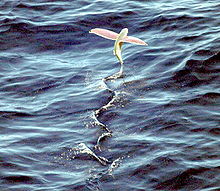By way of water.
To get a flying tetrapod you need a predecessor that can spare two limbs from full time locomotion such that they can differentiate into wings. The ancestors of birds are thought to have been semibipedal and semiarboreal - they could run on their back legs which opened the possibility of differentiation of the forelimbs into appendages first to aid in jumping and then wings to flap and fly.
The prospect of a crocodylomorph running around on hind legs seems a stretch. But there is another way to free up the 2 forelimbs of a tetrapod.
 http://novataxa.blogspot.com/2011/07/2010-geosaurus-dakosaurus.html
http://novataxa.blogspot.com/2011/07/2010-geosaurus-dakosaurus.html
Metriorhynchids were a peculiar group of fully marine Mesozoic
crocodylomorphs
This body plan is similar to other fully marine reptiles and mammals - a muscular tail in charge of propulsion and diminutive limbs used for steering, if that. Whales have done away completely with their hind limbs but looking over marine reptiles it seems like the forelimbs are what gets small.
In any case - here is a reasonable starting point for evolving a bird - a fully aquatic tail-propelled crocadylomorph which can spare its forelimbs for a new job.
We will accomplish this by way of the flying fish.

The flying fish propels itself via its strong tail and then once out of the water, uses its differentiated forefins to sustain itself. They fly to escape predators but also because it is fast and effectively increases the size of their habitat by allowing them to skip over draggy dangerous water.
Hold that down vote! I am aware that flying fish do not fly, only glide. I assert that they never developed true flight because they are residents of the open ocean. There is no place for them to go except open water and open air. But our croc protobirds do have a place to go. Here is where they live.
 https://www.marlimillerphoto.com/swamps.html
https://www.marlimillerphoto.com/swamps.html
The brackish cypress / mangrove swamps are good habitats for small predators. The croc protobirds make their livings here. But larger things live there too - including other crocodilians (as have always been the apex predators in such habitats) and larger croc protobirds. The juvenile croc protobirds can escape large predators, including their hungry great uncles, by putting on a burst of speed and then gliding, just as a flying fish.
Like the flying fish, a phenotype evolved for escaping predators can also be used to enlarge habitat - the croc protobird can skip over shallow water and swampy areas common in this ecosystem. Unlike the flying fish, the juvenile croc protobirds might sometimes find themselves in a tree at the end of their flight. Trees are full of insect life, and crabs are the apex predators here - all delicious meals for a juvenile croc protobird in a flight for its life one minute and in a banquet the next.
Neoteny is a great method for evolution. Neotenous croc protobirds do not get big and waterbound, retaining their access to the safe havens and rich pickings of the mangroves. Initially the croc protobirds would have to get a runup in the water using the tail and then jump out to get into a tree. Once in the tree it will probably eventually have to go back into the water. This is analogous to the terrestrial ancestors of birds, which probably jumped or climbed into trees for safe havens / feeding but had to go back down the earth to get from tree to tree.
A croc protobird which can push off from a tree and use its flying fins to help it through the air to another tree can get access to trees unreachable from the water. I envision the long swimming tail becoming prehensile, in the way of chameleons. This crocdylomorph is on its way to becoming a bird.



